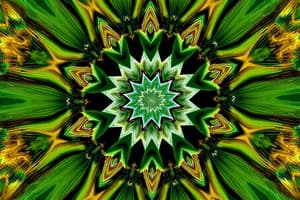Podcast
Questions and Answers
Which of the following is NOT an application of mathematics?
Which of the following is NOT an application of mathematics?
- Controlling overpopulation
- Creating art (correct)
- Predicting the sun’s behavior
- Controlling a pandemic
What are patterns in nature?
What are patterns in nature?
Repetitive sequences found in color, shape, action, or other forms.
What is symmetry according to the American Heritage Dictionary?
What is symmetry according to the American Heritage Dictionary?
- A form without any structure
- An exact correspondence of form on opposite sides (correct)
- A chaotic arrangement of parts
- Random configurations
Rotational symmetry means that a shape looks the same after being rotated by several degrees.
Rotational symmetry means that a shape looks the same after being rotated by several degrees.
What are fractals?
What are fractals?
The most common number of petals in flowers is ___.
The most common number of petals in flowers is ___.
What is the Fibonacci sequence?
What is the Fibonacci sequence?
How many pairs of rabbits will there be at the beginning of the fourth month?
How many pairs of rabbits will there be at the beginning of the fourth month?
What happens to the number of rabbit pairs in the Fibonacci rabbit problem every month?
What happens to the number of rabbit pairs in the Fibonacci rabbit problem every month?
What type of symmetry is also known as mirror symmetry?
What type of symmetry is also known as mirror symmetry?
Patterns in nature are sequences that do not follow a specific rule.
Patterns in nature are sequences that do not follow a specific rule.
What does rotational symmetry indicate about an object?
What does rotational symmetry indicate about an object?
Mathematics expresses ______ that are found in nature.
Mathematics expresses ______ that are found in nature.
Match the type of symmetry with its description:
Match the type of symmetry with its description:
Which of the following is NOT considered a type of pattern observed in nature?
Which of the following is NOT considered a type of pattern observed in nature?
The natural world contains beauty that can be quantified and represented mathematically.
The natural world contains beauty that can be quantified and represented mathematically.
Give an example of a natural phenomenon where mathematics is applied.
Give an example of a natural phenomenon where mathematics is applied.
What type of symmetry allows an object to maintain its size and shape when moved to another location?
What type of symmetry allows an object to maintain its size and shape when moved to another location?
Spiral patterns begin at the edges and move towards the center point.
Spiral patterns begin at the edges and move towards the center point.
What is the unique characteristic of fractals?
What is the unique characteristic of fractals?
Flowers with ___ petals are the most common in nature.
Flowers with ___ petals are the most common in nature.
Match the following types of patterns with their descriptions:
Match the following types of patterns with their descriptions:
Which of the following flowers has 3 petals?
Which of the following flowers has 3 petals?
All flower petal counts listed are numbers in the Fibonacci sequence.
All flower petal counts listed are numbers in the Fibonacci sequence.
What is a characteristic feature of patterns observed in animals?
What is a characteristic feature of patterns observed in animals?
Flashcards are hidden until you start studying
Study Notes
Application of Mathematics
- Mathematics is essential for predicting solar behavior and natural phenomena.
- It plays a crucial role in managing issues like overpopulation and pandemics.
Mathematics in Nature
- The natural world displays various beautiful shapes, patterns, and colors that can be described mathematically.
- Ian Stewart's book "Nature by Numbers" emphasizes the universe's inherent patterns.
Patterns in Nature
- Patterns are repetitive sequences found in nature, expressed mathematically through rules.
- These patterns can encompass colors, shapes, actions, or other recurring sequences.
Types of Symmetry
- Symmetry: Accurate correspondence of form on opposite sides of a dividing line or plane.
- Reflection Symmetry: Also known as mirror symmetry; divides an object into two identical mirror-image halves.
- Rotational Symmetry: Similar parts arranged around a central axis, appearing identical after certain rotations.
- Translational Symmetry: Maintains size and shape when an object is moved to a different location.
Types of Patterns in Nature
- Fractals: Infinite patterns that are self-similar across various scales.
- Spiral Patterns: Circular patterns starting at a center point, expanding outward.
- Spots and Stripes: Patterns seen in animal appearances.
- Flower Petals: Generally vibrant with common Fibonacci numbers—3 for Lilies, 5 for Buttercups, 8 for Delphiniums, 13 for Marigolds, 21 for Asters, and 34, 55, 89 for Daisies.
Number Patterns and Sequences
- Recognizes triangular number patterns, inviting speculation about subsequent layers.
- The Fibonacci sequence, originating in the Middle Ages, highlights natural occurrences in sequencing.
Fibonacci Sequence
- Named after mathematician Leonardo Pisano Bigollo; Fibonacci was instrumental in introducing the Arabic number system to Europe.
- The sequence starts with a pair of rabbits reproducing monthly, illustrating exponential growth: 1, 1, 2, 3, 5, 8, etc.
- The growth of rabbit pairs serves as a practical application of the Fibonacci sequence, answering how breeding progresses month by month.
Application of Mathematics
- Mathematics plays a crucial role in predicting the behavior of celestial bodies, such as the sun.
- It is utilized to forecast natural phenomena and potential calamities.
- Mathematical models help manage and control overpopulation.
- Mathematics aids in strategizing responses to pandemics.
Patterns in Nature and the World
- Nature exhibits a variety of beautiful shapes and patterns, all of which can be mathematically described.
- Ian Stewart's book "Nature by Numbers" emphasizes the prevalence of patterns in the universe.
What Does Mathematics Have to Do with Nature?
- The natural world contains intricate designs and vibrant colors that can be analyzed through mathematics.
Understanding Patterns
- Patterns consist of repetitive sequences found in nature, including colors, shapes, and actions.
- Mathematics serves as a language to express these patterns, guided by specific rules for calculation and problem-solving.
Types of Patterns in Nature
-
Symmetry:
- Defined as an exact correspondence of form across a dividing line or plane.
- Reflects how an object can be bisected into mirror-image halves.
-
Types of Symmetry:
- Reflection Symmetry: Also known as mirror symmetry, divides an object into two mirror-image sections.
- Rotational Symmetry: Exhibited by objects with parts arranged around a central axis, maintaining the same appearance upon rotation.
- Translational Symmetry: Occurs when an object retains its size and shape even when moved to a different location.
-
Fractals:
- Patterns that are self-similar at various scales and appear the same regardless of magnification.
-
Spiral Patterns:
- Circular designs expanding outward from a center point.
-
Spots and Stripes:
- Found in animal appearances, demonstrating patterns in their external features.
-
Flower Petals:
- Flowers often display specific petal counts, with five petals being the most common; these numbers frequently align with the Fibonacci sequence:
- Lilies: 3 petals
- Buttercups: 5 petals
- Delphiniums: 8 petals
- Marigolds: 13 petals
- Asters: 21 petals
- Daisies: 34, 55, 89 petals
- Flowers often display specific petal counts, with five petals being the most common; these numbers frequently align with the Fibonacci sequence:
Number Patterns and Sequences
- Certain sequences, such as the Fibonacci sequence, manifest in various natural contexts and are characterized by specific numerical properties.
Studying That Suits You
Use AI to generate personalized quizzes and flashcards to suit your learning preferences.




